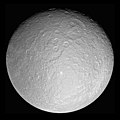File:PIA07763 Rhea full globe5.jpg

Size o this luikower: 600 × 600 pixels. Ither resolutions: 240 × 240 pixels | 480 × 480 pixels | 768 × 768 pixels | 1,024 × 1,024 pixels | 2,048 × 2,048 pixels | 4,920 × 4,920 pixels.
Oreeginal file (4,920 × 4,920 pixels, file size: 2.67 MB, MIME type: image/jpeg)
File history
Clap oan ae date/time fer tae see the file aes it kithed at that time.
| Date/Time | Thummnail | Dimensions | Uiser | Comment | |
|---|---|---|---|---|---|
| current | 07:15, 27 August 2018 |  | 4,920 × 4,920 (2.67 MB) | PlanetUser | Reverted to version as of 08:13, 13 March 2015 (UTC) |
| 10:09, 15 August 2018 |  | 4,920 × 4,920 (2.66 MB) | The NMI User | Reverted to version as of 23:49, 14 August 2018 (UTC) | |
| 23:59, 14 August 2018 |  | 4,920 × 4,920 (2.64 MB) | The NMI User | rv, fixed | |
| 23:49, 14 August 2018 |  | 4,920 × 4,920 (2.66 MB) | The NMI User | Try making black | |
| 23:44, 14 August 2018 |  | 4,920 × 4,920 (2.65 MB) | The NMI User | Fixed | |
| 08:09, 13 August 2018 |  | 4,920 × 4,920 (3.67 MB) | The NMI User | Removing black borders | |
| 08:01, 13 August 2018 |  | 4,920 × 4,920 (2.67 MB) | The NMI User | Reverted to version as of 08:13, 13 March 2015 (UTC) | |
| 07:56, 13 August 2018 |  | 4,920 × 4,920 (5.67 MB) | The NMI User | Black background | |
| 08:13, 13 Mairch 2015 |  | 4,920 × 4,920 (2.67 MB) | MoreTomorrow | making square (to match other planet/moon images) | |
| 06:43, 30 October 2008 |  | 4,920 × 4,820 (2.68 MB) | WolfmanSF | This is the same full-resolution NASA image, with black panels added to the margins and some Photoshop processing to enhance contrast. |
Eimage airtins
The follaein pages airts tae this image:
Global file uisage
The follaein ither wikis uise this file:
- Uisage on af.wikipedia.org
- Uisage on ar.wikipedia.org
- قالب:المجموعة الشمسية
- قائمة أجرام المجموعة الشمسية مرتبة حسب الحجم
- قائمة أجرام النظام الشمسي المستديرة بالجاذبية
- قائمة الأقمار الطبيعية
- خط زمني لاكتشاف كواكب المجموعة الشمسية وأقمارها
- اكتشاف واستكشاف النظام الشمسي
- قائمة أنواع الكواكب
- بوابة:زحل/مقالة مختارة وصورة لأحد أقمار زحل
- قائمة أكبر الفوهات في المجموعة الشمسية
- 1981 ميداس
- Uisage on ary.wikipedia.org
- Uisage on arz.wikipedia.org
- Uisage on ast.wikipedia.org
- Uisage on as.wikipedia.org
- Uisage on azb.wikipedia.org
- Uisage on be.wikipedia.org
- Uisage on bh.wikipedia.org
- Uisage on ca.wikipedia.org
- Uisage on ckb.wikipedia.org
- Uisage on de.wikipedia.org
- Uisage on el.wikipedia.org
- Uisage on en.wikipedia.org
- Pioneer 11
- Rhea (moon)
- Cassini–Huygens
- Timeline of discovery of Solar System planets and their moons
- List of geological features on Rhea
- Naming of moons
- List of natural satellites
- List of gravitationally rounded objects of the Solar System
- Wikipedia:WikiProject Astronomy/Recognized content
- Portal:Solar System
- Portal:Solar System/Selected picture
- User:Dabomb87/Sandbox
- Tirawa (crater)
View mair global usage o this file.


